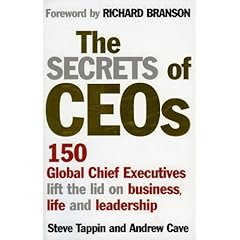The Secrets of CEOs

 I just finished reading an advance US manuscript of 'The Secrets of CEOs - 150 Global Chief Executives lift the lid on business, life and leadership' by Steve Tappin, who is a managing partner in the global CEO & board practice of Heidrick & Struggles, and Andrew Cave, a leading English financial journalist.
I just finished reading an advance US manuscript of 'The Secrets of CEOs - 150 Global Chief Executives lift the lid on business, life and leadership' by Steve Tappin, who is a managing partner in the global CEO & board practice of Heidrick & Struggles, and Andrew Cave, a leading English financial journalist.
The book has a definite English slant despite being very much about the global economy, and provides fascinating insight through extensive interviews of the large enterprise CEO lifestyle.
Some of the core focuses of the book are around globalization strategies, effective sustainability, the next generation web, waging 'the first world war for talent' and of course coping with the credit crunch.
While the book is all about what it takes to be a relevant and effective leader of a 21st century enterprise, some of the most fascinating areas of a very thought provoking book for me were around the demise of command and control as a viable management style and widespread enthusiasm for modern collaborative techniques.
...Leading CEO's believe that the 200 year old Western manufacturing derived model of efficiency driving businesses will be inadequate in coming years and will need to be rethought. They also recognize that the Western command and control style of management is out of date in most situations. Command and control is characterized by issues being funneled to the top and then decisions being passed back down from on high - but they're often the wrong decisions taken by managers who who are removed from customers and the day to day reality...
...Above all, such businesses are not appropriate settings in which to take long term decisions that require multi constituency decisions that are as yet hard to quantify in financial terms - the kind of decisions that companies will increasingly have to take...
...Our research found that top chief executives believe that they must organize their businesses more organically. In the next decade many successful companies will replace command and control with more fluid and fast-moving cell-like organizations. We describe how a chief executive provides business leadership at the nucleus of the cell by giving greater freedom to act to much more decentralized operations, while still policing performance...
It's hugely encouraging to read about the challenges of real C level strategy and oversight in a federated business world recognizing the issues around collaboration stratefy.
..."I think command and control is dead," states Ben Verwaayen (former CEO of British Telecom). "Location and time is dead. It has to be on different notions. That will be appealing to many people but also ...very scary for boards".
The central problem with command and control is its failure to engage people by offering them meaningful work and freedom to innovate. John Weston, former CEO of BAE Systems , says "Throwing tablets of stone from the top just does not work. But getting people fired up about what they can achieve and giving them the freedom to be masters of their own destiny is a better way - and they appreciate it". Great businesses will provide employees with a place to think and a global meritocracy to grow within.
'Secrets of the CEO's' is primarily around leadership styles, defining CEO's as commercial executors, financial value drivers, corporate entrepreneurs, corporate ambassadors or global missionaries (or a combination of the above). Section III, 'leading into the future', provides a intriguing consensus of CEO collaboration tactics.
In my opinion, just as imperiously 'Throwing tablets of stone from the top just does not work', strategic planning and thinking also needs careful follow through to execute collaboration tactics effectively across enterprises and groups. The hard work of flushing out unscrupulous middle management self preservation strategies, such as revolving door hiring, stealing of ideas from the innovators they manage and transferring credit to themselves or new favorites, cliquey management styles and their associated cold shoulder techniques are equally important.
A combination of high level strategic planning and tactical follow through is critical to effective transparent collaboration execution, with people and their processes the driver for appropriate technology adoption. Identifying opaque mid level management bottlenecks is an important facet of planning effective strategy.
The Secrets of CEOs is published by Nicholas Brealey, is available now in the UK and will be published in November 2008 in the USA. I found it a fascinating, thought provoking read.